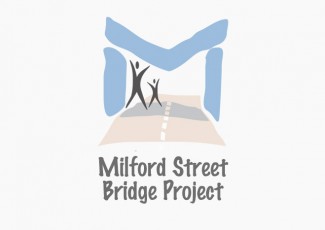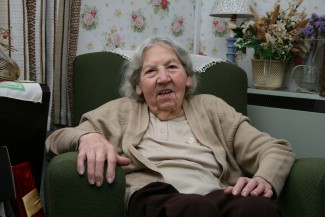Phyllis Maple : Childhood and Education
Rita L. Jacob


The life story of Phyllis Muriel Maple is a long one; recounted in great detail by Phyllis, herself, in a series of interviews for the Milford Street Bridge Project. Spanning over nine decades and two World Wars, it begins at a time when horse drawn carts rumbled along Rampart Road and ends in 2010 with the ever present hum of traffic above her Guilder Lane garden; in many respects, Phyllis’s history reflecting that of the area in which she has always lived.
Phyllis Muriel was the third of six children born to Herbert and Ada Selwood who lived at 37 Rampart Road. As in many families, however, not all survived, the eldest, Dorothy Emancia Mary, dying during an epidemic of Scarlet Fever; probably before the start of the First World War. Also, one child was still born and another lived only a few days; Phyllis’s own birth on 30 September 1919 being difficult because she was an unusually large baby weighing eleven and a quarter pounds.
The first two years of Phyllis’s life were ones of hardship; her father returning from two years of captivity in Germany malnourished and unable to find work, despite being a skilled craftsman.
‘they fed the pigs better than they fed us, that was my dad’s words about it, and she said … he was all bloated when he came home, and … then he didn’t do any work then for, two years would be between me an’ my sister being born … because there wasn’t, work was not available, although my father was a trained carpenter’
Raised in a rural environment, however, he grew vegetables, kept bees and snared rabbits in order to feed his family; his wife also being used to living ‘off the land’. Fortunately for the family, Herbert eventually found employment in the Cathedral Close while Ada acquired several cleaning jobs in the vicinity; including one at the residence of Bishop Webb’s widow.
Phyllis and her sister, Joan, often accompanied their mother during school holidays, gathering the windfall apples to supplement family meals. Phyllis also went with her father when he tended the various gardens, at the age of eleven, being paid half a crown (25p) for carrying out a chauffeur’s duties while he was on holiday. These included cleaning the boots and knives before leaving for school, her breakfast having been eaten in the Servants’ Hall.
‘I can remember too when I was eleven, I went (to work) in Parkers just inside High St. Ann’s gate … in the mornings for, I think it was two weeks when the chauffeur used to go on holiday I used to go down and clean the boots n’ the knives ‘cos in those days we had steel knives and they had to be cleaned with … some sort of polish I had to get them clean and then I used to go into the, servants’ hall and have a breakfast before I left there n’ have to run like the devil to get to school on time’
At this time, Phyllis was a pupil at St. Edmund’s; having previously attended St. Martin’s Infants and George Herbert’s Girl’s School. Her memories of education, however, are mostly connected with the buildings themselves and various craft activities rather than academic subjects; to an certain extent, reflecting contemporary attitudes to female education. In Phyllis’s family, her brother’s apprenticeship took priority; her own aspirations to become a teacher being sacrificed because of the costs involved:-
‘I would have liked to have been a teacher that was my ambition but my mum, said that because men have to earn a living all their lives and girls get married n’ they don’t work or they didn’t in those days and she said they couldn’t afford to keep me at school until I was a sixteen and then going on to university and things like that I couldn’t do it because my brother had to be re-apprenticed’
Therefore, upon leaving George Herbert’s, Phyllis did not go to the Grammar School as she wished but to St. Edmund’s where girls learnt skills that would be useful when they had their own homes. Phyllis, however, enjoyed many of the practical actives, like her mother, becoming a good cook. She remembers knitting garments for the Gates triplets and later made many of her own children’s clothes. Also, both she and her brother were keen on sport; Phyllis belonging to different school teams.
Throughout her childhood, Phyllis maintained an interest in Natural Science; her neighbour, Roy Pitman, being a naturalist who collected butterflies and birds eggs. The Selwood children helped him do this; the countryside then being just a short distance away. On these walks, Phyllis was taught the names of the wild flowers she picked, often winning competitions held at her school, the Primrose League and St. Ann’s Club.
‘Yes Mr Roy Pitman he was a regular local naturalist and … I learnt an awful lot of thing about newts n’ ur went fishing and we caught newts and a different things ‘n’ all the wild things that were [there] because we didn’t have to go very far in those days and of course we always walked because there wasn’t any transport you walked and you walked all up over the downs and you picked all the downside flowers ‘n’ and you used to take a sandwich and a bottle of water or something to drink lemonade’
In this respect, Phyllis and her siblings enjoyed a freedom almost unknown by children today; it also being possible to play games such as Birds, Beasts and Flowers across Rampart Road disturbed only by the occasional horse and cart. Ball games, however, were usually played on the Greencroft as the children knew they would be in trouble if a window was broken; the Greencroft then being much bigger and used for grazing sheep before the Britford Sheep Fair.
The Greencroft was also a place where local residents gathered on 5 November; Phyllis recalling how she and other children collected rubbish for bonfires and pennies for fireworks:-
‘Boys and girls used to go round n’ collect all the rubbish from the different households an’ burn it all up in yer Greencroft, and they’d pinch some from somebody else’s bonfire to make their’s bigger while they was gone to get some more from somewhere else an’ it was good fun an’ we used to have a guy we used to make a guy an’ used to say ‘penny for the guy’ n’ then you used to buy fireworks with the pennies’
Phyllis describes her family as being workers not shirkers; she and her siblings always helping with household tasks and the allotment in Britford Lane. Even during holidays they did odd jobs; these being spent on the farm where her grandfather was a shepherd:-
‘I used to ride the farm horses down the big shire horses, ride them down to work in the mornings because the carter lived and Granny and Grandad lived on the top of the hill and the farm was down the hill and down the lane and … we rode down to work and [they] put us to doing all odd jobs’
Nevertheless, despite being poor and working hard, the Selwood family was a happy one in which rows and arguments being unknown.
‘We were all very happy family, there were no, no rows or arguments or anything like that well you know, everything seemed to, stay in its place n’ work out if you know what I mean [pause] We all did, things that we … had to do n’ help out so that you mucked in together so you were … well part of a team I suppose you say’
These traits were to be perpetuated in Phyllis’s own marriage to Reginald Percy Maple; a union that was to last over fifty years.







No Comments
Add a comment about this page